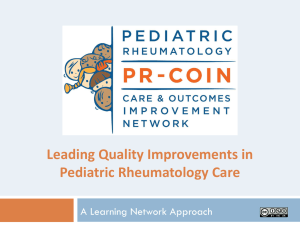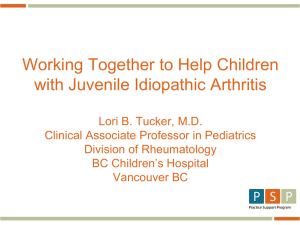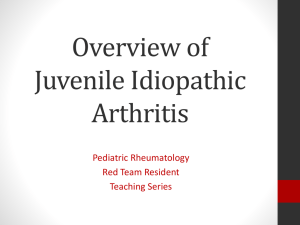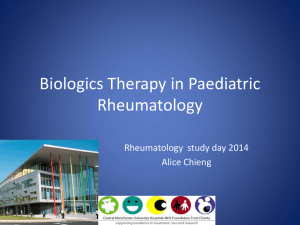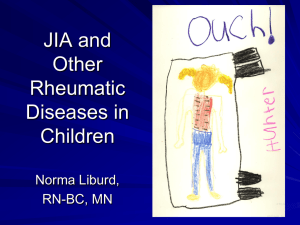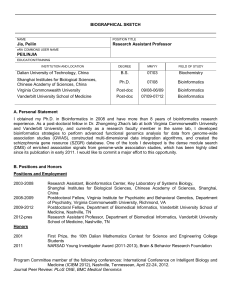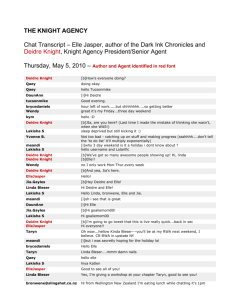Draft guideline on clinical investigation of medicinal products
advertisement
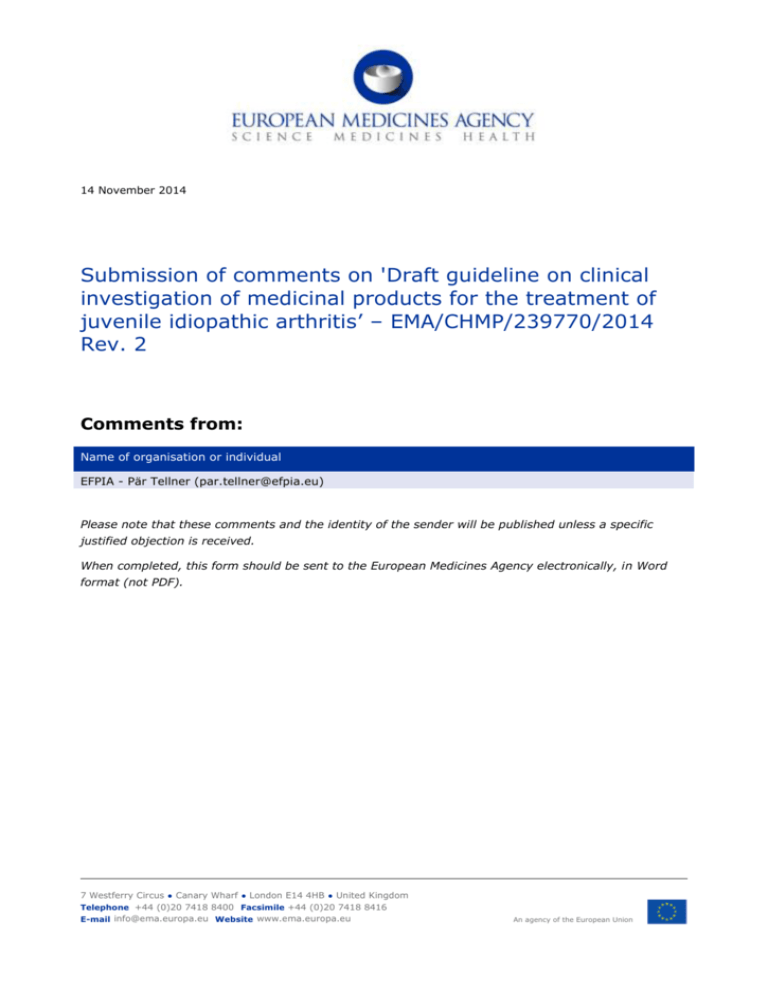
14 November 2014 Submission of comments on 'Draft guideline on clinical investigation of medicinal products for the treatment of juvenile idiopathic arthritis’ – EMA/CHMP/239770/2014 Rev. 2 Comments from: Name of organisation or individual EFPIA - Pär Tellner (par.tellner@efpia.eu) Please note that these comments and the identity of the sender will be published unless a specific justified objection is received. When completed, this form should be sent to the European Medicines Agency electronically, in Word format (not PDF). 7 Westferry Circus ● Canary Wharf ● London E14 4HB ● United Kingdom Telephone +44 (0)20 7418 8400 Facsimile +44 (0)20 7418 8416 E-mail info@ema.europa.eu Website www.ema.europa.eu An agency of the European Union 1. General comments Stakeholder number General comment (if any) Outcome (if applicable) (To be completed by (To be completed by the the Agency) Agency) EFPIA welcome the opportunity to provide comments on the draft revised JIA guideline. We have identified a few major comments we expect to be addressed in the forthcoming finalised guideline: 1. Targeted approach to therapy: As EMA points out, the understanding of the pathophysiology of the different types of JIA has evolved greatly in the past few years, which has changed the recommendations for treatment. The currently recommended targeted approach to therapy now supports fewer categories of JIA being studied for new therapeutics such that fewer children would be unnecessarily exposed to inappropriate therapeutics. As an example, current data for systemic JIA strongly implicate the IL-1 and IL-6 pathways and targeted treatments have been recommended (Ringold, 2013). An additional example can be seen in the differences between the therapeutic responses to IL-17 inhibition of patients with psoriatic arthritis versus those with rheumatoid arthritis (Mease, 2014), consistent with a more prominent pathophysiologic role of the IL-17 pathway in psoriatic arthritis, and perhaps the broader seronegative spondyloarthropathy category (Fitzgerald, 2014). In order to prevent the exposure of a broad group of children to an experimental intervention where efficacy is not anticipated, the target paediatric population should be chosen based on: 1. The latest information regarding each JIA subset disease pathology 2. Response to treatment in the most closely analogous adult disorder Mease PJ, Genovese MC, Greenwald MW et al. Brodalumab, an anti-IL17RA monoclonal antibody, in psoriatic arthritis. N Engl J Med 2014; 370: 2295-306 Ringold S, Weiss PF, Beukelman T et al. Update of the 2011 American College of Rheumatology recommendations for the treatment of juvenile idiopathic arthritis. Arthritis Rheum 2013; 65:2499-251 Fitzgerald O and Winchester R. Emerging evidence for critical involvement of the Interleukin-17 pathway in both psoriasis and psoriatic arthritis. Arthritis Rheuma 2014; 66:1077-1080 Examples of suggested revisions: 2/10 Stakeholder number General comment (if any) Outcome (if applicable) (To be completed by (To be completed by the the Agency) Agency) Lines 107-109: “Whenever the development of a new medicinal product is considered in any of the (above mentioned) adult diseases, the inclusion of JIA in the development is required, unless there is reason to believe that the product is likely to be ineffective or unsafe in part or all of the paediatric population, or there is evidence that the therapy would target a particular JIA subset ” Lines 110-113: “Although the aetiology and pathogenesis of JIA are not fully understood, it is however known that JIA shares many of the pathological abnormalities that have been identified in RA. Increased production of cytokines in different forms of JIA (e.g.interleukin1ß and interleukin-6 in systemic JIA, TNF-α in polyarticular JIA) in conjunction with osteoclastic cell activation leads to degradation of adjacent cartilage and bone.” Lines 172-173: “The ILAR category of each patient enrolled into trials needs to be defined (i.e. if the adult indication is psoriatic arthritis the paediatric equivalent is juvenile psoriatic arthritis). The subset as this is important for cross-trial comparisons.” 2. Use of registries Registries in some JIA populations will be very difficult if not impossible to enrol due to low prevalence of the disease. Disease-based registry may require cross-company collaboration, which may not be feasible. It should be clarified that an OLE is appropriate and sufficient for some indications.. Detailed comments are also provided below in section 2 - “Specific Comments on the text”. 3/10 2. Specific comments on text Line number(s) of the relevant text (e.g. Lines 2023) Lines 79-85 Stakeholder number (To be completed by the Agency) Comment and rationale; proposed changes (If changes to the wording are suggested, they should be highlighted using 'track changes') Outcome (To be completed by the Agency) Comment: This paragraph implies that all JIA is one disease, however the individual JIA categories describe diseases with differing pathogenesis and phenotypic features In addition, in ERA boys predominate; this should also be made clearer. Proposed change (if any): JIA refers to arthritis of at least 6 weeks duration of unknown aetiology that begins in children less than 16 years old. The International League of Associations for Rheumatology (ILAR) classification of JIA identifies the following 7 mutually exclusive categories: systemic arthritis, oligoarthritis (persistent or extended), rheumatoid factor [RF] negative polyarthritis, RF positive polyarthritis, psoriatic arthritis, ERA, and undifferentiated arthritis. Overall, JIA has an annual incidence of 0.008-0.226 per 1000 children and a prevalence of 0.07-4.01/1000 children. JIA is less common than RA in adults but it is one of the most common systemic autoimmune diseases in children and adolescents. Children of all age groups may be affected although onset during the first year of life is rare and restricted predominantly to systemic JIA. In some of the categories girls predominate whereas in ERA boys predominate, and there are racial differences in incidence and relative frequency of JIA subtypes. Lines 92-101 Comment: Suggest that the wording be changed to reflect that in the literature to clarify that the joint count that is used in the definition is the number of joints affected over the course of the disease rather than the number of affected joints at a particular time point. Ref: Petty RE et al.: International League of associations for rheumatology Classification of Juvenile Idiopathic Arthritis: Second Revision, Edmonton, 2001; J Rheumatol 2004; 31(2):390-392 4/10 Line number(s) of the relevant text (e.g. Lines 2023) Stakeholder number (To be completed by the Agency) Comment and rationale; proposed changes (If changes to the wording are suggested, they should be highlighted using 'track changes') Outcome (To be completed by the Agency) Proposed change: “The currently used ILAR classification distinguishes the following JIA categories: • Systemic JIA (sJIA) • Polyarthritis rheumatoid factor negative • Polyarthritis rheumatoid factor positive • Oligoarticular arthritis (2 subcategories of arthritis affecting one to 4 joints during the first 6 months of disease based on joint count after 6 months) Persistent (affecting not more than 4 joints throughout the disease course not more than 4 joints) Extended (affecting a total of more than 4 joints after the first 6 months of disease more than 4 joints) • Psoriatic arthritis (JIA-PsA) • Enthesitis related arthritis (ERA) • Undifferentiated arthritis” Lines 110-115 Comment: This paragraph suggests again that all JIA shares the same pathogenesis. This is clearly not the case if one looks at heredity and phenotypic manifestations. Proposed change (if any): Although the aetiology and pathogenesis of JIA are not fully understood, it is however known that some forms of JIA share many of the pathological abnormalities that have been identified in RA, but multiple differing pathogenesis and phenotypic features exist between JIA sub-categories. Increased production of cytokines (e.g.interleukin-1ß interleukin-6, TNF-α) in conjunction with osteoplastic cell activation leads to degradation of adjacent cartilage and bone. Increased knowledge of these factors may help to redefine the classification of JIA in terms of aetiology, response to treatment, risk of relapse or prognosis. 5/10 Line number(s) of the relevant text (e.g. Lines 2023) Lines 116-119 Stakeholder number (To be completed by the Agency) Comment and rationale; proposed changes (If changes to the wording are suggested, they should be highlighted using 'track changes') Outcome (To be completed by the Agency) Comment: This is only true for specific types of JIA and is not true for ERA which has acute anterior uveitis as inclusion criteria for classification. Acute anterior uveitis is not ANA associated. Proposed change (if any): JIA is a major cause of disability in children. In addition specific types of JIA may be accompanied by chronic anterior iridocyclitis/uveitis particularly in anti-nuclear antibody (ANA) positive females. In ERA acute anterior uveitis prevalence is not associated with ANA status. Early ophthalmology referral, early diagnosis and treatment are the major determinants of prognosis in uveitis associated with JIA. Line 134 Comment: Suggest adding the word “prevention” to treatment so as not to imply that all drugs should be tested in children who already have macrophage activation syndrome. Proposed change: “In addition to suppressing signs and symptoms of arthritis, the ultimate goal of treatment of JIA in all categories should be the induction of remission for which, validated criteria have been described, or the attainment of minimal disease activity or inactive disease. The aim of modern treatment of JIA is rapid suppression of inflammation in order to prevent joint damage, maximise physical function and promote normal growth and development. In addition, in some categories, additional goals are relevant such as control of systemic signs and symptoms including fever, treatment of uveitis, treatment or prevention of macrophage activation syndrome and reduction of corticosteroid dose.” Lines 170-171 Comment: It is stated that only the occurrence of “significant adverse events in animals or adults” could prevent the inclusion of children from the age of 1. Other reasons such as, mechanism of action, expected lack of benefits over existing treatments, can also be a justification for not 6/10 Line number(s) of the relevant text (e.g. Lines 2023) Stakeholder number (To be completed by the Agency) Comment and rationale; proposed changes (If changes to the wording are suggested, they should be highlighted using 'track changes') Outcome (To be completed by the Agency) including the younger age groups. Lines 174 and 189 Comment: The guideline indicates the following: “The ACR has identified five target JIA treatment groups”. Then later on: “Each of the 4 target patient population groups”. It is unclear how many populations need to be studied separately, four or five? Please clarify. Lines 223-226 Comment: The draft guideline recommends that “Other treatment modalities interfering with study treatment are of particular importance. Concomitant non-pharmacological treatment (e.g. physical therapy) and medication for diseases other than rheumatic disease must be completely documented and where possible it is recommended that these treatments are standardised and predefined.” The requirement that concomitant non-pharmacological treatment (e.g. physical therapy) must be documented completely may not be feasible since adequate records may not be available as nonpharmacological treatment is not usually done at the physicians’ office. There is also no standardised and widely acceptable method to record non-pharmacological treatments in JIA patients. Proposed change (if any): Concomitant non-pharmacological treatment (e.g. physical therapy) and medication for diseases other than rheumatic disease must should be completely documented and where possible it is recommended that these treatments are standardised and predefined, where possible. Line 228 Comment: The title is not fully aligned with the content of the section : extrapolation is not restricted to efficacy. It is also successfully applied (as discussed in the Concept paper) for safety, and for PK and PD. Proposed change (if any): 7/10 Line number(s) of the relevant text (e.g. Lines 2023) Stakeholder number (To be completed by the Agency) Comment and rationale; proposed changes (If changes to the wording are suggested, they should be highlighted using 'track changes') Outcome (To be completed by the Agency) It is suggested to revisit the title, e.g. extrapolation of efficacy opportunities. Lines 243-245 Comment: This may not be appropriate for types of JIA such as oligoarticular and ERA which have fewer active joints than polyarticular JIA. The likelihood of achieving a 30/50/70% change is dependent on the number of joints active at baseline. Additionally, different JIA types may have differing frequency of CRP or ESR elevation while still having active disease. An alternative endpoint, short of LDA or remission as noted to be acceptable below, should be recommended. Mean percent change from Baseline to Week 12 in the number of active joints with arthritis has also been accepted by the CHMP as the primary endpoint. Proposed change (if any): The primary endpoint chosen depends on the category of JIA being studied and the design of the trial. For parallel randomised trials in all JIA categories other than sJIA, the recommended primary endpoint is the change in ACR paediatric core set criteria. Other endpoints such as mean percent change from Baseline to Week 12 in the number of active joints with arthritis may also be justified. Line 281 Comment: The guidelines highlight the limitation of ACR and recommend the use of JADAS as a secondary endpoint. Could change in JADAS be used as a primary endpoint? Line 306 Comment: Add “or body weight related” after age-specific Proposed change (if any): Age-specific and/or body weight related changes... 8/10 Line number(s) of the relevant text (e.g. Lines 2023) Lines 414 to 416 and lines 452 to 459 Stakeholder number (To be completed by the Agency) Comment and rationale; proposed changes (If changes to the wording are suggested, they should be highlighted using 'track changes') Outcome (To be completed by the Agency) Comment: The proposed draft revised guideline recommends conducting postauthorisation efficacy and safety observational registry studies in a systematic manner. The guideline should be clear that this is the case when only short term data is available from clinical trials and should recognise that there are different methods to assess the long-term efficacy and safety of a product that must be discussed and evaluated on a case by case basis. Proposed change (if any): Lines 414 to 416: “Because the marketing authorisation would be is based on limited information on short-time efficacy (and safety), it is necessary to collect further data from patients treated with the medicinal product after marketing, e.g. in an open label extension study or the observational registry-type of study.” Lines 453 to 459: The long-term evaluation of safety requires collection of data from larger number of patients for a longer period of time, potentially into adulthood. Therefore safety data should also be collectedin the postmarketing observational registry-type studies period (see section 6.2.4.). Observational registry-type studies may be one approach to the collection of such data. The protocols for such studies should define and record the identifiable or theoretical risks of the medicinal product. The registry should preferably be an established disease-based (rather than product-based) clinical registry and allow collection of long-term data from a sufficient number of patients treated with different medicinal products. Acceptance of data from disease-specific registry for fulfilment of post-marketing obligations needs to be agreed in advance. Line 417 Comment: “The following minimum set of data is recommended to be collected (as appropriate to the specific disease(s) being studied):…” To add consistency throughout the document. 9/10 Line number(s) of the relevant text (e.g. Lines 2023) Lines 431 to 434 Stakeholder number (To be completed by the Agency) Comment and rationale; proposed changes (If changes to the wording are suggested, they should be highlighted using 'track changes') Outcome (To be completed by the Agency) Comment: “It is expected that options of dose-reduction and dose-interruption and re-treatment at relapse are addressed which could be performed in a randomised withdrawal phase (see section 6.2.1.)”. While treatment interruption is part of the randomized withdrawal study design, and re-treatment is often available outside of the study (e.g. in an open-label extension study) assessment of dose reduction would add another dimension to this randomised withdrawal trial design. It will not always be possible and relevant to study both dosereduction and dose-interruption in the same paediatric trial. The guideline should state that at least one of these options, i.e. dosereduction or dose-interruption, should be studied. Proposed change (if any): “It is expected that options of dose-reduction and or dose-interruption and re-treatment at relapse are addressed which could be performed in a randomised withdrawal phase (see section 6.2.1.)”. Lines 449-451 Comment: It is unclear if this statement refers to effects on the immune system that are specific to children and cannot be addressed in adults. Proposed change: It would be preferable to address as many of these questions in adults and only conduct studies in children when necessary. Please add more rows if needed. 10/10
